Palms growing in containers are susceptible to the same deficiencies that landscape palms experience, but the relative importance of the various deficiencies as well as their causes are different. Container substrates are generally more acid and have greater nutrient-holding capacity than Florida native soils. Thus leaching and insolubility of nutrients are much less of a problem. Also, container-grown palms are often fertilized with more complete controlled-release fertilizers or regular liquid fertilization, which prevents most deficiencies from occurring.
Most potting substrates consist largely of organic components such as bark or peat that have high carbon- to-nitrogen ratios. This means that the microbes that break down these components need a supplementary source of N in order to do so. These soil microbes will therefore be competing with plant roots for N. It should be no surprise then that N is by far the most important limiting element in container production.
Nutrient Deficiencies
Most palm nutrient deficiencies are easily diagnosed by symptoms alone. However, in some instances leaf analysis can be helpful. When sampling for leaf analysis, select four to six central leaflets from the youngest fully-expanded leaf. Soil analysis is not particularly useful for diagnosing palm nutrient deficiencies, since palm nutrient symptomology often bears little resemblance to soil nutrient profiles.
Nitrogen deficiency symptoms in palms begin first on the oldest leaves as a uniform light green coloration. The golden-colored petioles and leaf bases commonly observed on container-grown Dypsis lutescens are caused by N deficiency (Figure 1). As symptoms progress, the entire canopy except for the spear leaf becomes uniformly chlorotic (sometimes nearly white in color) and growth rate is reduced sharply (Figure 2). Palms can linger in a chronic N-deficient state for some time.
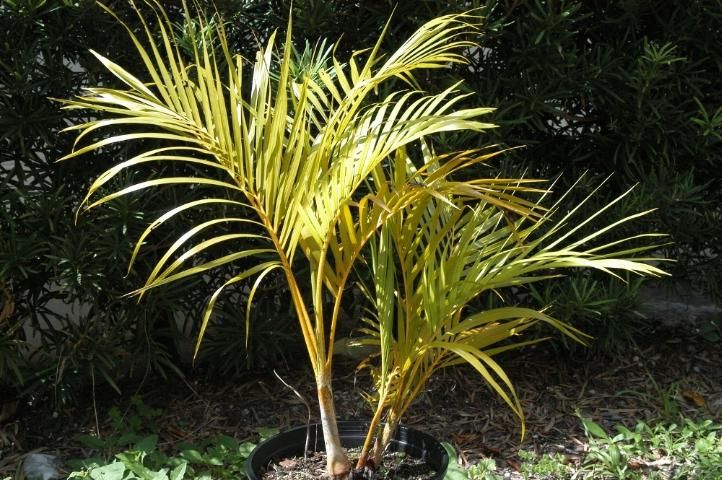
Credit: T. K. Broschat, UF/IFAS
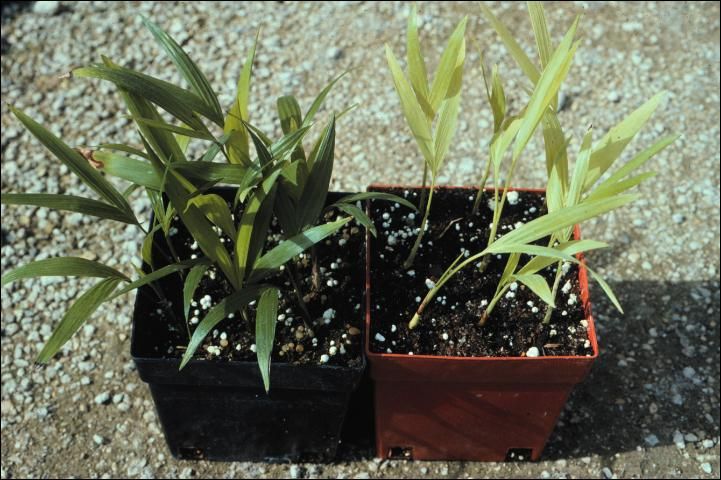
Credit: T. K. Broschat, UF/IFAS
Potassium deficiency is the most widespread nutrient deficiency in field-grown and landscape palms, yet is relatively uncommon and seldom a serious problem in container-grown palms. Early symptoms in most species include translucent yellow to orange or necrotic spotting on the oldest leaves (Figure 3). As symptoms become more severe, marginal and/or tip necrosis of the distal leaflets on the oldest leaves may also occur (Figure 4). In some species there is no spotting, and leaflet marginal or tip necrosis will be the only symptom. In many of these species, these necrotic leaflet tips will be curled or frizzled in appearance. Potassium deficiency symptoms are always more severe towards the tip of a leaf and least so towards the leaf base. Similarly, symptoms decrease in severity from oldest to youngest leaves.
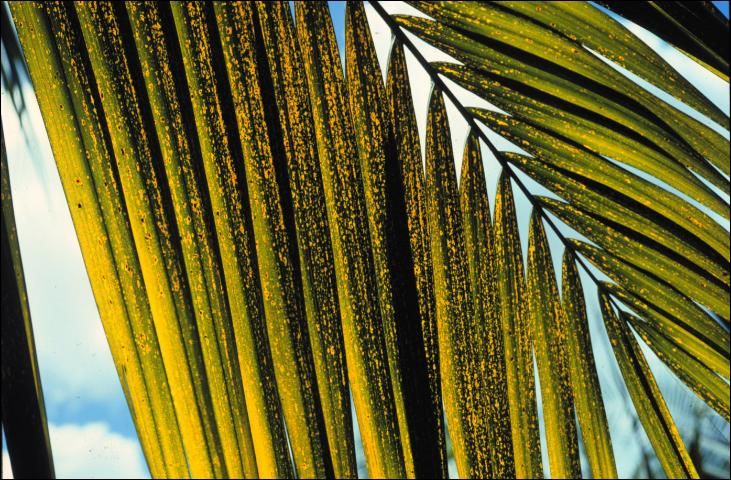
Credit: T. K. Broschat, UF/IFAS
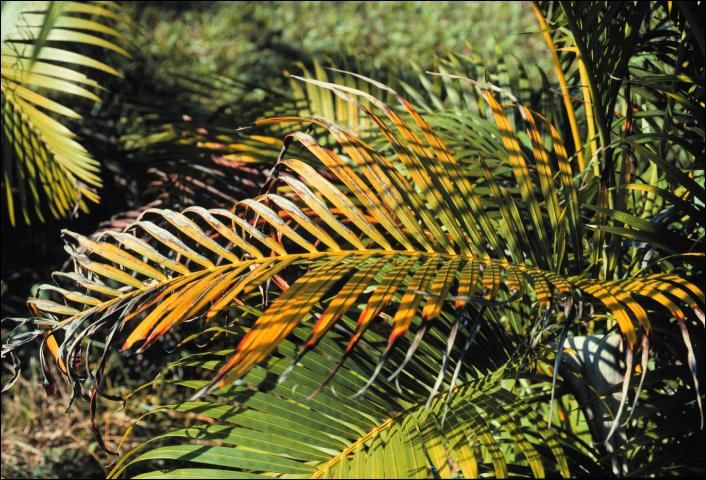
Credit: T. K. Broschat, UF/IFAS
Magnesium deficiency may occur on palms held for long periods of time in the same container, since the dolomite incorporated into the potting substrate initially is usually exhausted after about six months. It will also be seen on palms growing in substrates to which insufficient dolomite has been added. Symptoms of Mg deficiency are most severe on the oldest leaves and appear as broad yellow bands along the periphery of the entire leaf, or in some fan palms, around each leaflet (Figures 5 and 6). In all cases, the central portion of the leaf or leaflet remains distinctly green. Potassium deficiency differs from Mg deficiency in that with K deficiency there is a gradual transition from green at the base of an old leaf, through yellow or orange discoloration in the middle, and finally to leaflet tip necrosis at the end of the leaf. Magnesium deficiency never causes leaflet tip necrosis and, if this is observed on an obviously Mg-deficient leaf, it is because K deficiency is also present on that leaf.
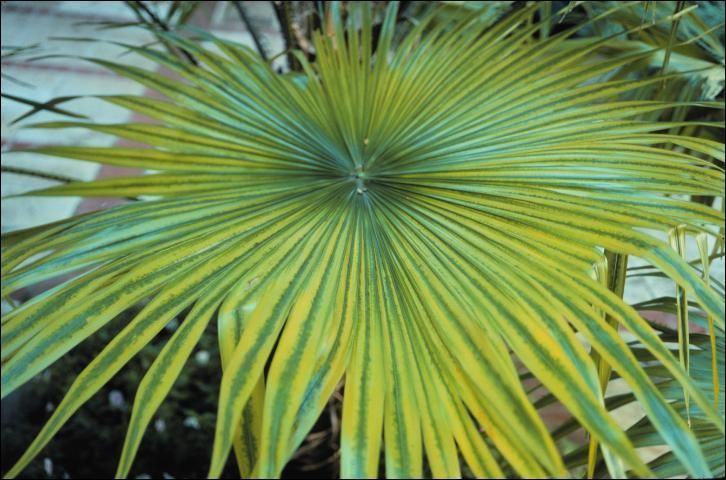
Credit: T. K. Broschat, UF/IFAS
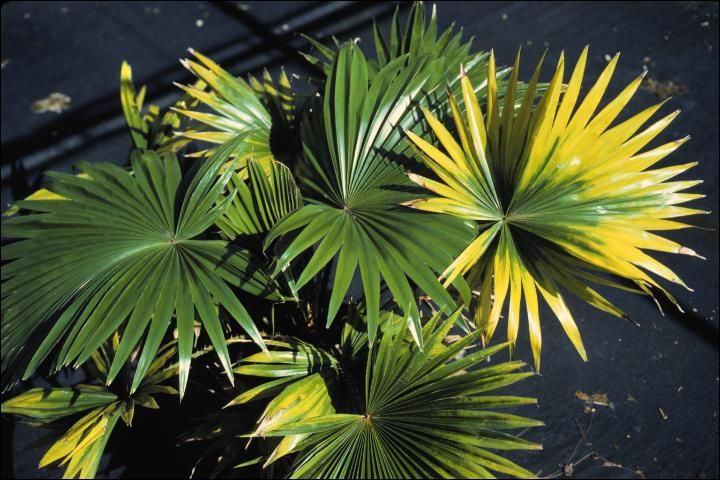
Credit: T. K. Broschat, UF/IFAS
Iron deficiency is relatively common in container-grown palms, especially those grown in the same container for long periods of time. Over time, most organic substrate components such as bark or peat decompose to poorly aerated muck. It is poor soil aeration that is responsible for the vast majority of Fe deficiency, since under anaerobic conditions, roots cannot respire and produce the energy needed to actively take up Fe from the soil. Root rot diseases or soluble salts injury, which reduce root surface area, are also commonly expressed above ground as Fe chlorosis.
Symptoms of Fe deficiency occur only on the youngest leaves, but in a chronic state, the entire palm crown may be chlorotic. Newly emerging Fe-deficient leaves are either uniformly yellow-green to nearly white, or may have slightly greener veins (Figure 7). In a few species, such as Syagrus romanzoffiana, Rhapis spp., and some Licuala spp., these chlorotic new leaves may have diffuse 1/8-inch green spots scattered throughout the leaf (Figure 8).
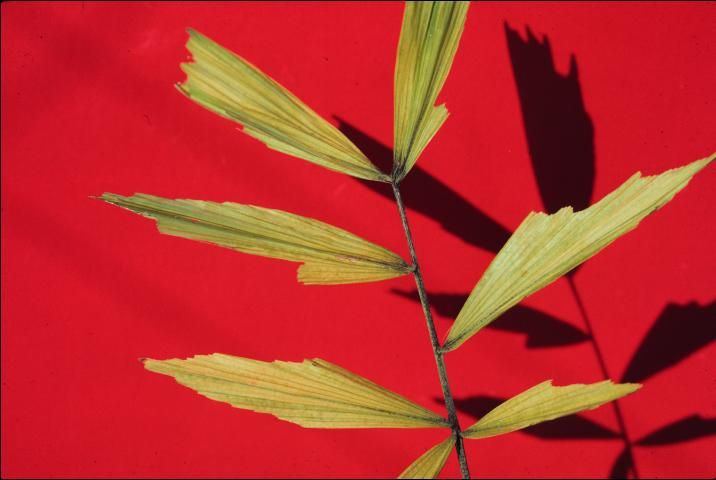
Credit: T. K. Broschat, UF/IFAS
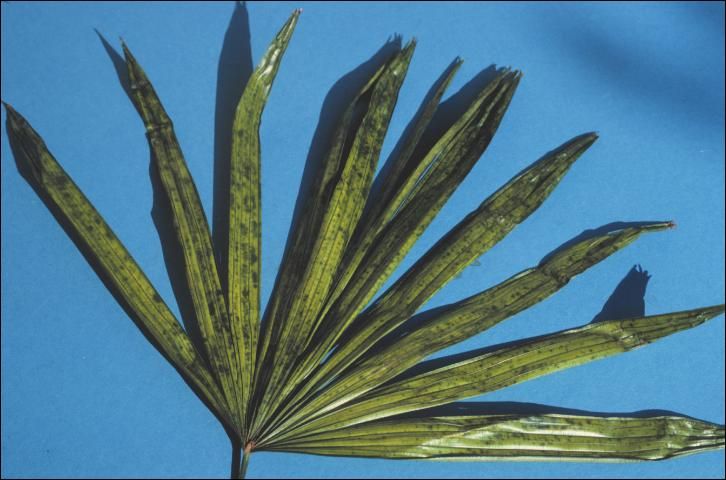
Credit: T. K. Broschat, UF/IFAS
The only other nutrient deficiency occasionally encountered in container production of palms is Mn deficiency. In mild form, its symptoms are identical to those of Fe deficiency except that interveinal or longitudinal necrotic streaking will be superimposed on the chlorotic leaflets of new leaves (Figure 9). As the deficiency increases in severity, the distal parts of affected leaflets will become completely necrotic and curled. Manganese deficiency symptoms are most severe towards the bases of new leaves and least so towards the tip (Figure 10).

Credit: T. K. Broschat, UF/IFAS

Credit: T. K. Broschat, UF/IFAS
Fertilization of Palms in Containers
Fertilization of container-grown palms is fairly simple and is similar to that used for the production of other woody or tropical foliage plants. Fertilizers high in N such as 18N-6P2O5-12K2O work well for container-grown palms. Controlled-release fertilizers used at the high end of the manufacturers' recommended rates should be used. However, Mg must be provided by incorporating 12 to 15 lb. of dolomite per cubic yard of potting substrate. Contrary to popular opinion, the primary purpose of incorporating dolomite into potting substrates is not to increase pH, but rather as a slow release form of Ca and Mg. Both elements are required in large amounts by palms and are not usually provided at adequate levels by commonly used controlled-release fertilizers.
Similarly, a micronutrient blend, preferably one containing sulfate forms of Mn, Zn, Cu, and Fe, should be incorporated into the potting substrate at a rate of about 1.5 to 2 lb. per cubic yard. Although popular resin-coated fertilizers may contain micronutrients, research has shown that release of these micronutrients by the coatings is often incomplete. Controlled-release fertilizers can be top-dressed, incorporated, or layered under the liner when potting up palms. Research has shown that layering is the most effective method of applying these products when growing palms, and incorporation is the least effective.
An alternative method of fertilizing container-grown palms is the use of liquid fertilizers injected into the irrigation water at each irrigation. Under such systems, a complete water-soluble nutrient fertilizer having an elemental ratio of approximately 3N-1P2O5-2K2O and preferably containing Mg and micronutrients, can be injected at a rate of about 200 ppm N. Research has shown that controlled-release fertilizers are slightly better than liquid fertilization, both in terms of palm growth response and in terms of reducing nutrient leaching losses into the environment.
If deficiencies of N, P, or K already exist, their correction consists of simply applying a good 3N-P2O51-2K2O ratio controlled-release fertilizer to the surface of the potting substrate. However, if deficiencies of Mg, Fe, or Mn are encountered, specific treatment for that deficiency may be required. For Mg deficiency, surface application of prilled kieserite or coated Mg product should be effective. Similarly, manganese sulfate is the most effective treatment for Mn deficiency. However, since Fe deficiency is usually caused by some problem with substrate aeration or root health, addition of Fe fertilizers is usually not very helpful. Correction of these cultural causes of the Fe deficiency is usually all that is required to re-green these palms. For palms growing in degraded, poorly aerated substrates, it will be necessary to knock off the degraded potting substrate and replant the palm in fresh substrate. When growing slow-growing palm species that will remain in a particular container for a long period of time, it is important not to over-pot them, thus causing them to stay too wet, and also to use a durable, well-aerated potting substrate that will not quickly degrade.
References
Broschat, T.K. 1995. Nitrate, phosphate, and potassium leaching from two species of container-grown plants fertilized by several methods. HortScience 30:74–77. https://doi.org/10.21273/HORTSCI.30.1.74
Broschat, T.K. 2009. Palm nutrition and fertilization. HortTechnology 19:6990 694. https://doi.org/10.21273/HORTTECH.19.4.690
Broschat, T.K. and K.A. Moore. 2007. Release rates of ammonium-nitrogen, nitrate-nitrogen, phosphorus, potassium, magnesium, iron, and manganese from seven controlled-release fertilizers. Commun. Soil Sci. Plant Anal. 38:843 850. https://doi.org/10.1080/00103620701260946
Elliott, M.L., T.K. Broschat, J.Y. Uchida, and G.W. Simone. 2004. Compendium of ornamental palm diseases and disorders. Amer. Phytopath. Soc. Press, St. Paul, MN.